|
|

QoS Policy Manager is composed of several separate programs, but you mainly use these two programs.
Web-based policy reporting is a key element in both these programs.
The following sections help you create and distribute QoS policies.
These sections describe the main Policy Manager window, and how to start and stop the application.
Start Policy Manager to create, change, delete, and view your QoS policies.
Policy Manager automatically opens the online QoS database.
The main Policy Manager window (Figure 3-1) is divided into 3 panes.
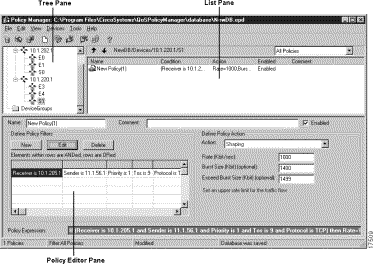
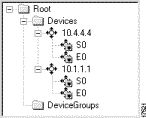
The tree view pane (Figure 3-2) contains folders for each device you are managing in the Devices folder. A device folder contains a list of interfaces on which you define QoS policies.
The tree view also contains a Device Groups folder, which contains the device groups you have defined. Device groups are groups of interfaces that you intend to manage using identical policies. You must treat all interfaces in a device group identically.
The tree view pane is where you start when creating a policy. If the device is not yet defined in the QoS database, you must first define it and add its interfaces. If the device is already defined in the QoS database, you must select the interface on which you want to define a policy before you can create (or change) the policy.

The list view pane (Figure 3-3) shows the policies that are defined on the interface or device group selected in the tree view. You can change how these policies are displayed using the commands in the View menu (see "Changing the Policy Manager Display").
Each policy is preceded by an icon that indicates the status of the policy. Table 3-1 describes these icons.
The top bar of the list view includes these items.
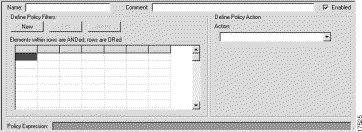
The policy editor (Figure 3-4) is where you create, change, and view your policies. It contains these major areas.
The group has these buttons and a grid that contains the filter conditions.
Cells in the same row are conjoined, or ANDed, together. A packet must fulfill the conditions in all of the cells in a single row in order for the packet to be considered to have satisfied the row's filter.
Different rows are disjoined, or ORed, together. If a packet fulfills the filter conditions in any row, it is considered to have fulfilled the filter for the policy.
You can use the standard Windows cut, copy, and paste functions to manipulate text in the policy editor pane in the main QoS Policy Manager window.
Step 2 Use these commands to cut, copy, or paste.
You can change the main Policy Manager window to display information according to your preferences. Table 3-2 lists the available commands for changing the main Policy Manager window.
Table 3-2 Changing the Policy Manager Main Window
You must periodically save your changes to the QoS database. However, saving your changes to the database does not apply those changes to the network. You must use Distribution Manager to deploy your new or changed policies to the network.
When you save your changes, a job is added to the Distribution Manager. If you frequently save your work, the accumulated changes from the last time you distributed the policies is represented by one job in Distribution Manager.
Your changes are saved to the open database.
From the Policy Manager interface, you can close just Policy Manager, or exit both Policy Manager and Policy Distribution Manager.
Figure 3-5 shows the network used in subsequent lessons to illustrate how to use QoS Policy Manager to create and deploy QoS policies.
This network has three areas that we will concentrate on.
1. The segments that contain the major servers used in the network. These servers are connected to the network through routers R1 and R4.
2. The segments that contain the HR and Finance users, connected to the network through router R2. The HR and Finance users primarily use the Enterprise Resource Planning (ERP) server, but they do not use the web server as a significant part of their network usage. They also use the FTP/Mail server.
3. The segments that contain the Sales users, connected to the network through router R3. The Sales users use both the ERP and web server as a significant part of their network usage. They also use the FTP/Mail server.
Here are other technical details of the network that you need to know in order to follow the lessons.
Other interface and device addresses may be used throughout the lessons.
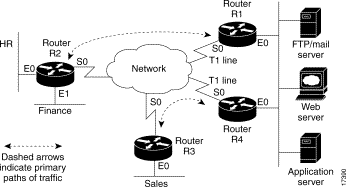
In this lesson, you will learn how to add a router to the QoS database and create and deploy a simple policy. The policy in this example sets the IP precedence for web traffic that goes through router R4 (see Figure 3-5 for the overall network diagram). The purpose of this policy is to color the web traffic for the Sales group, because the web server behind R4 hosts a significant application used by Sales, and Sales requires good response from this server.
In order to make a meaningful policy, we must not only color the traffic on the inbound interface to the router (interface E0, which connects the web server to R4), but we must choose a QoS property for the outbound interface S0 (Figure 3-6). We will implement weighted fair queuing (WFQ). This ensures that the packet coloring we perform on E0 is used by the router.

At the end of this lesson, you should be able to
If you want to create a policy and deploy it on a router that exists in your network, obtain the IP address of an appropriate router. Otherwise, you can use a fake IP address so that you can follow these steps without affecting your network.
The New Device window is displayed.
In our example, router R4 is 10.4.4.4, the community string is public, and both passwords are test (Figure 3-7).
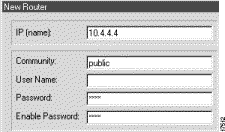
(c). On the New Device window, click Verify Device Info. This obtains the IOS software version information from the router, as well as the router model. (If you are not using a real router, fill in the Vendor, Software Version, and Device Model fields manually.)
In our example, router R4 is a Cisco 7200 running IOS software release 11.2 (Figure 3-8).

(d). On the New Device window, click Detect Interfaces. This closes the New Device window and obtains the list of interfaces that are available on the router.
QoS Policy Manager creates a folder for the router in the tree view using the IP address of the router. The router's interfaces are included as members of this folder.
(If you are not using a real router for this exercise, you must deselect Verify Device Information and click Define Interfaces. Then fill in the New Interface window for the S0 and E0 interfaces.)
Figure 3-9 shows the tree view that now includes router R4.
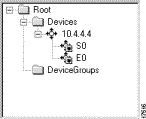
Step 2 Configure the QoS property on the S0 interface so that it uses weighted fair queuing. We do not need to change the QoS property of the E0 interface because we are only creating a policy for inbound traffic for E0.
The Interface Properties window appears.
(b). Select Weighted Fair in QoS Property (Figure 3-10) and click OK.
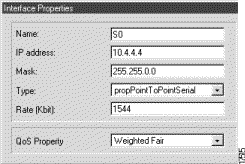
Step 3 Define a policy to color web traffic on the inbound interface (E0 on router R4).
(a). Select the E0 interface in the tree view.
(b).  Click the New Policy button, or select File>New>Policy.
Click the New Policy button, or select File>New>Policy.
QoS Policy Manager adds a policy to the list view, and makes the policy editor pane active.
(c). In the policy editor pane, change the name of the policy and add a meaningful comment. For this policy, use "WebTraffic" and "Color web traffic for Sales organization."
QoS Policy Manager opens the Define Policy Filter window.
(e). In the Define Policy Filter window, select these values to indicate the policy is for inbound web traffic.
Use the default values for all other fields in the window. Click OK when finished.
QoS Policy Manager adds your filter conditions to the filters grid in the policy editor pane.
QoS Policy Manager expands the Define Policy Action group to include the Precedence value.
(g). Choose 4 in the Precedence field, to give a higher priority to the traffic that satisfies the policy's filter.
Figure 3-11 shows the complete Policy Manager window after you have finished this step.

Step 4  Click the Save button, or select File>Save, to save your policy changes.
Click the Save button, or select File>Save, to save your policy changes.
Step 5 Distribute your policies to the network.
(a).  Click the Distribution Manager button, or select Tools>Distribution Manager, to start Distribution Manager.
Click the Distribution Manager button, or select Tools>Distribution Manager, to start Distribution Manager.
(b). In Distribution Manager, select the job that appears in the tree view. In this example, it is job 1, the only job that appears.
When you select the job, QoS Policy Manager displays the contents of the job in the list view, which shows the devices whose configurations will be changed by the job. If you double-click the device name in the list view, QoS Policy Manager displays the IOS commands that will be sent to the device when you apply the job.

QoS Policy Manager starts applying the changes defined in the job to the network devices. You can view the results of the jobs in the logs displayed in the bottom pane of Distribution Manager.
In this lesson, you will learn how to treat a set of device interfaces as a group, and create and deploy a simple policy across the members of that group. The policy in this example will set the IP precedence for Enterprise Resource Planning (ERP) traffic that goes through routers R1 and R4 (see Figure 3-5 for the overall network diagram). The purpose of this policy is to color the ERP traffic for the HR, Finance, and Sales organizations, because the ERP servers behind R1 and R4 host significant applications used by these organizations, and they require good response from this server.
In order to make a meaningful policy, we must not only color the traffic on the incoming interfaces to these routers (the E0 interfaces, which connect the ERP server to R1 and R4), but we must choose a QoS property for the outbound interfaces S0 (Figure 3-13). We will implement weighted fair queuing (WFQ) on the outbound interfaces. This ensures that the packet coloring we perform on E0 is used by the routers.

At the end of this lesson, you should be able to
If you want to create a policy and deploy it on a device that exists in your network, obtain the IP address of an appropriate device. Otherwise, you can use a fake IP address so that you can follow these steps without affecting your network.
This lesson assumes you have completed the steps in "Lesson 3: Creating a Simple Policy for Managing Web Traffic on One Router."
The New Device window is displayed.
In our example, router R4 is 10.1.1.1, the community string is public, and both passwords are test.
(c). On the New Device window, click Verify Device Info. This obtains the IOS software version information from the router, as well as the router model. (If you are not using a real router, fill in the Vendor, Software Version, and Device Model fields manually.)
In our example, router R1 is a Cisco 7200 running IOS software release 11.2.
(d). On the New Device window, click Detect Interfaces. This closes the New Device window and obtains the list of interfaces that are available on the router.
QoS Policy Manager creates a folder for the router in the tree view using the IP address of the router. The router's interfaces are included as members of this folder.
(If you are not using a real router for this exercise, you must deselect Verify Device Information and click Define Interfaces. Then fill in the New Interface window for the S0 and E0 interfaces.)

Step 2 Create a device group for the S0 interfaces on routers R1 and R4, and set the QoS property for these interfaces to weighted fair queuing.
(a). Select Devices>Device Group>New, or select the DeviceGroups folder in the tree view, right-click, and select New Device Group.
QoS Policy Manager opens the Device Group window.
(b). In the Device Group window, Group Properties group, fill in these fields.
Figure 3-15 shows the completed Group Properties group.
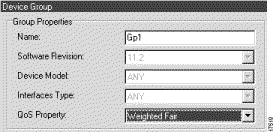
QoS Policy Manager opens the Device Group Members window.
(d). In the Device Group Members window, use Ctrl+click to select the 10.1.1.1\S0 and 10.4.4.4\S0 interfaces, and click >> to add them to the group (Figure 3-16). Click OK when finished.
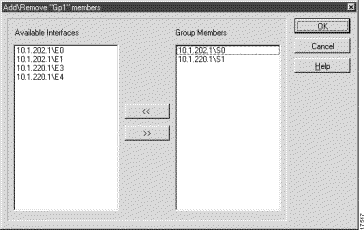
Figure 3-17 shows the Device Group window after you have added the S0 interfaces as group members.
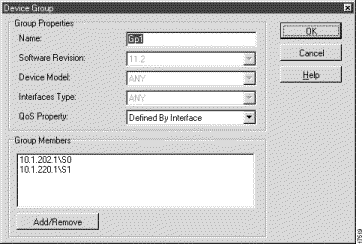
Step 3 Create a device group for the E0 interfaces on routers R1 and R4.
(a). Select Devices>Device Group>New, or select the DeviceGroups folder in the tree view, right-click, and select New Device Group.
QoS Policy Manager opens the Device Group window.
QoS Policy Manager opens the Device Group Members window.
(d). In the Device Group Members window, use Ctrl+click to select the 10.1.1.1\E0 and 10.4.4.4\E0 interfaces, and click >> to add them to the group. Click OK when finished.
QoS Policy Manager adds the interfaces to the Group Members list in the Device Group window.
Figure 3-18 shows the tree view with the completed device group entries.

Step 4 Create a policy on the EdgeGroupInbound group to color ERP traffic.
(a). Select the EdgeGroupInbound group in the tree pane.
(b).  Click the New Policy button, or select File>New>Policy.
Click the New Policy button, or select File>New>Policy.
QoS Policy Manager adds a policy to the list view, and makes the policy editor pane active.
(c). In the policy editor pane, change the name of the policy and add a meaningful comment. For this policy, use "ERPTraffic" and "Color ERP traffic for the HR, Finance, and Sales organizations."
QoS Policy Manager opens the Define Policy Filter window.
(e). In the Define Policy Filter window, select these values to indicate the policy is for inbound ERP traffic. Since the ERP server in this example is dedicated to the ERP applications, as is typically the case, we color all traffic from the server. If other applications were on the same server as the ERP application, we would also use a port filter.
Use the default values for all other fields in the window. Click OK when finished.
QoS Policy Manager adds your filter conditions to the filters grid in the policy editor pane.
QoS Policy Manager expands the Define Policy Action group to include the Precedence value.
(g). Choose 5 in the Precedence field, to give a higher priority to the traffic that satisfies the policy's filter.
Step 5  Click the Save button, or select File>Save, to save your policy changes.
Click the Save button, or select File>Save, to save your policy changes.
Step 6 Distribute your policies to the network.
(a).  Click the Distribution Manager button, or select Tools>Distribution Manager, to start Distribution Manager.
Click the Distribution Manager button, or select Tools>Distribution Manager, to start Distribution Manager.
(b). In Distribution Manager, select the job that appears in the tree view. In this example, it is job 2.
When you select the job, QoS Policy Manager displays the contents of the job in the list view, which shows the devices whose configurations will be changed by the job. If you double-click the device name in the list view, QoS Policy Manager displays the IOS commands that will be sent to the device when you apply the job.
QoS Policy Manager starts applying the changes defined in the job to the network devices. You can view the results of the jobs in the logs displayed in the bottom pane of Distribution Manager.
In this lesson, you will learn how to limit the bandwidth that is available to a specific application. The policy in this example will limit FTP traffic that goes through the outgoing interfaces on routers R1 and R4 (see Figure 3-5 for the overall network diagram). The purpose of this policy is to prevent FTP traffic from flooding the network and thus reducing performance of the more important applications on the network.
Traffic shaping policies or limiting policies are typically used on outbound interfaces. We define an application service alias for FTP traffic from the central site, and use the alias to set the limit for FTP traffic to 200 KB/sec (Figure 3-19).

At the end of this lesson, you should be able to
If you want to create a policy and deploy it on a device that exists in your network, obtain the IP address of an appropriate device. Otherwise, you can use a fake IP address so that you can follow these steps without affecting your network.
This lesson assumes you have completed the steps in "Lesson 4: Coloring Enterprise Resource Planning (ERP) Traffic on a Group of Devices."
QoS Policy Manager opens the Application Services window.
QoS Policy Manager opens the Application Service window.
(c). In the Application Service window, fill in the required information to identify the source of the FTP traffic, and to give the application service alias a name.
In this example, we will identify the FTP traffic by using these attributes (Figure 3-20)
Click OK when finished to return to the Application Services window.

Step 2 Create a policy on the EdgeGroupOutbound interface to limit the bandwidth available to FTP traffic.
(a). Select EdgeGroupOutbound in the tree view.
(b).  Click the New Policy button, or select File>New>Policy.
Click the New Policy button, or select File>New>Policy.
QoS Policy Manager adds a policy to the list view, and makes the policy editor pane active.
(c). In the policy editor pane, change the name of the policy and add a meaningful comment. For this policy, use "FTPTraffic" and "Limit bandwidth for FTP traffic."
QoS Policy Manager opens the Define Policy Filter window.
(e). In the Define Policy Filter window, select the CentralServicesFTPServer application service in the Source group.
QoS Policy Manager fills in the fields defined by the application service alias. You cannot change these values unless you deselect the application service. Click OK when finished.
QoS Policy Manager adds your filter conditions to the filters grid in the policy editor pane.
QoS Policy Manager expands the Define Policy Action group to include the rate, burst size, and exceed burst size values.
(g). Enter 200 in the Rate field, leaving the other fields blank. If you want, you can enter burst sizes to allow the router to use more bandwidth if it is available.
Step 3  Click the Save button, or select File>Save, to save your policy changes.
Click the Save button, or select File>Save, to save your policy changes.
Step 4 Distribute your policies to the network.
(a).  Click the Distribution Manager button, or select Tools>Distribution Manager, to start Distribution Manager.
Click the Distribution Manager button, or select Tools>Distribution Manager, to start Distribution Manager.
(b). In Distribution Manager, select the job that appears in the tree view. In this example, it is job 3.
When you select the job, QoS Policy Manager displays the contents of the job in the list view, which shows the devices whose configurations will be changed by the job. If you double-click the device name in the list view, QoS Policy Manager displays the IOS commands that will be sent to the device when you apply the job.
QoS Policy Manager starts applying the changes defined in the job to the network devices. You can view the results of the jobs in the logs displayed in the bottom pane of Distribution Manager.
In this lesson, you will learn how to create custom queues to deliver guaranteed bandwidth to specified types of traffic. The policies in this example will guarantee bandwidth for ERP traffic for the HR and Finance groups on the outgoing interfaces on router R1 (see Figure 3-5 for the overall network diagram). The purpose of this policy is to ensure that both groups get agreed-upon performance for their ERP applications.
Custom queuing policies are only effective on outbound interfaces, because the router cannot control the flow of packets on incoming interfaces. Because we have included R1/S0 in a device group in a previous lesson, we must first remove it from the device group so that we can treat R1/S0 and R4/S0 differently (Figure 3-19).

At the end of this lesson, you should be able to
If you want to create a policy and deploy it on a device that exists in your network, obtain the IP address of an appropriate device. Otherwise, you can use a fake IP address so that you can follow these steps without affecting your network.
This lesson assumes you have completed the steps in "Lesson 5: Limiting the Bandwidth Available to FTP Traffic."
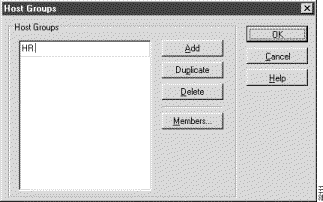
QoS Policy Manager opens the Host Groups window.
(b). Click in the first empty line in the host groups list and enter the name of the host group. In this example, use HR.
QoS Policy Manager opens the Host Group Members window.
(d). In the Host Group Members window, enter the list of machines used by the HR group. You can enter the names individually, or you can use a subnet mask to cover all machines within a subnet. In this example, we will use
Click OK when finished. QoS Policy Manager returns you to the Host Groups window.

QoS Policy Manager adds a new line to the host groups list.
(f). Click in the new empty line in the host groups list and enter the name of the host group. In this example, use Finance.
QoS Policy Manager opens the Host Group Members window.
(h). In the Host Group Members window, enter the list of machines used by the Finance group. In this example, we will use
Click OK when finished. QoS Policy Manager returns you to the Host Groups window.
Step 2 Remove the S0 interface for router R1 from the EdgeGroupOutbound device group.
(a). Double-click EdgeGroupOutbound in the tree pane, or select it and select Devices>Device Group>Properties.
QoS Policy Manager opens the Device Group window.
QoS Policy Manager opens the Device Group Members window.
(c). Select 10.1.1.1\S0 and click << to remove it from the group. Click OK when finished.
(d). QoS Policy Manager returns you to the Device Group window.
QoS Policy Manager tells you that it will keep the group-defined QoS property for the interface, and asks you whether you want to copy group-defined policies to the interface. Select Yes, so that the FTPTraffic policy remains active on the 10.1.1.1 S0 interface.
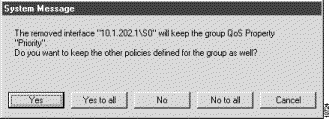
Step 3 Change the QoS property for the S0 interface.
(a). Double-click S0 in the 10.1.1.1 folder in the tree pane, or select it and select Devices>Interface>Properties.
QoS Policy Manager opens the Interface Properties window.
QoS Policy Manager adds the Packet Size parameter to the window. This value is used to determine the byte count for the custom queues that you will create on the interface. Enter a value that is average for the packets you expect. In this example, we will use 500.
Step 4 Create the custom queue for HR on the S0 interface.
(a). Select S0 in the 10.1.1.1 folder in the tree pane.
(b).  Click the New Policy button, or select File>New>Policy.
Click the New Policy button, or select File>New>Policy.
QoS Policy Manager adds a policy to the list view, and makes the policy editor pane active.
(c). In the policy editor pane, change the name of the policy and add a meaningful comment. For this policy, use "HR ERPTraffic" and "Custom queue for HR's ERP traffic."
QoS Policy Manager opens the Define Policy Filter window.
QoS Policy Manager adds your filter conditions to the filters grid in the policy editor pane.
(f). In the policy editor pane's Define Policy Action group, select Custom Queuing in the Action field.
QoS Policy Manager expands the Define Policy Action group to include the Ratio and Limit fields.
(g). Enter 30 in the Ratio field, leaving the Limit field. This provides 30% of the bandwidth to the HR group's ERP traffic.
You are now finished with the HR ERPTraffic policy.
Step 5 Now create the Finance ERPTraffic policy.
(a). Because the Finance ERPTraffic policy will be similar to the HR ERPTraffic policy, create a copy the HR ERPTraffic policy by right-clicking the policy in the list view and selecting Copy.
Then, right-click in the list view and select Paste.
QoS Policy Manager creates a new policy named Copy of HR ERPTraffic.
(b). In the policy editor pane, change the name of the Copy of HR ERPTraffic policy to "Finance ERPTraffic" and the comment to "Custom queue for Finance's ERP traffic."
QoS Policy Manager opens the Define Policy Filter window.
QoS Policy Manager changes the filter conditions in the filters grid in the policy editor pane.
(e). In the policy editor pane's Define Policy Action group, change the ratio to 20, leaving the Limit field. This provides 20% of the bandwidth to the Finance group's ERP traffic.
You are now finished with the Finance ERPTraffic policy.
Step 6  Click the Save button, or select File>Save, to save your policy changes.
Click the Save button, or select File>Save, to save your policy changes.
Step 7 Distribute your policies to the network.
(a).  Click the Distribution Manager button, or select Tools>Distribution Manager, to start Distribution Manager.
Click the Distribution Manager button, or select Tools>Distribution Manager, to start Distribution Manager.
(b). In Distribution Manager, select the job that appears in the tree view. In this example, it is job 4.
When you select the job, QoS Policy Manager displays the contents of the job in the list view, which shows the devices whose configurations will be changed by the job. If you double-click the device name in the list view, QoS Policy Manager displays the IOS commands that will be sent to the device when you apply the job.
QoS Policy Manager starts applying the changes defined in the job to the network devices. You can view the results of the jobs in the logs displayed in the bottom pane of Distribution Manager.
This lesson shows you how to configure a Level 3 switch, such as the Catalyst 8510. QoS controls forwarding based on IP precedence queuing of Fast Ethernet interfaces. Working on the basis of weighted round robin (WRR), each interface has four queuing number positions which can be a weighted value between 0 - 15.
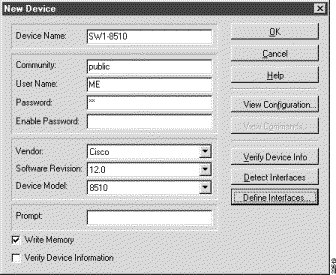
Step 2 Complete the information in the dialog window. Click Detect Interfaces to open the New Interface dialog window.
You will not see an interface on the Policy Manager tree view pane.
If you wish to define the interface yourself, click Define Interface and an empty New Interface dialog window appears.
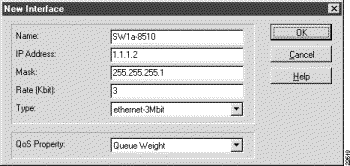
Step 3 Complete the information in the dialog window. In QoS Property you have the choice of Queue Weight or DON'T_CHANGE. Queue Weight applies the weighted queuing.
Step 4 Repeat steps 2 and 3 for each interface on which you wish to have queuing weights. An 8510 can have up to 32 interfaces.
Step 5 Click the New Policy icon in the toolbar or click New in the Define Policy Filters portion of the Policy Manager window. The SessionForm dialog box opens.
Step 6 Select Interface Source or Interface Destination or both. FastEthernet is the only choice in both source and destination.
If you configure just the destination interface, the queuing weights apply to destination interfaces only. If you configure just the source, the queuing weights apply all interfaces.
Step 7 Define the queue weights for each of the four queues. The queue weights can be in the range of 0 - 15, but should not exceed a sum of 15 or you are likely to exceed the bandwidth of the interface.
Step 8 When all the interfaces you wish to configure are done, click the Save icon in the tool bar or File>Save.
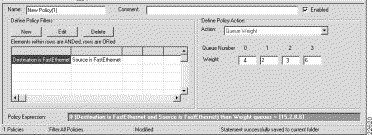
After the policy is saved in the database, the device will appear in the Distribution Manager for distribution to the device.
Step 9 Distribute your policies to the network.
(a).  Click the Distribution Manager button, or select Tools>Distribution Manager, to start Distribution Manager.
Click the Distribution Manager button, or select Tools>Distribution Manager, to start Distribution Manager.
(b). In Distribution Manager, select the job that appears in the tree view.
When you select the job, QoS Policy Manager displays the contents of the job in the list view, which shows the devices whose configurations will be changed by the job. If you double-click the device name in the list view, QoS Policy Manager displays the IOS commands that will be sent to the device when you apply the job.
QoS Policy Manager starts applying the changes defined in the job to the network devices. You can view the results of the jobs in the logs displayed in the bottom pane of Distribution Manager.
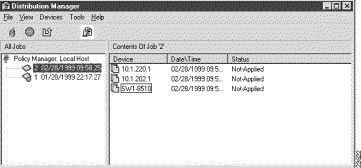
This lesson will teach you how to use LocalDirector to map systems on any hardware into one or more virtual machines that can load balance TCP/IP connections across all the real systems. This means that many real servers appear as one virtual IP address, enabling server farms to require only one DNS entry. It also provides for multiple virtual IP addresses to map to one real server.
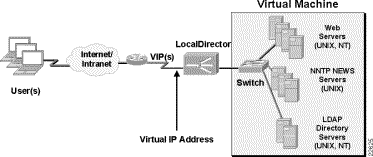
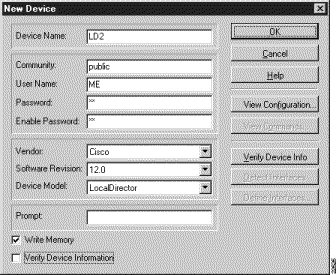
Step 2 Complete the entries in the dialog window. Click OK when completed.
Step 3 Click New in the Define Policy Filters frame of the Policy Manager window. This opens the Define LocalDirector Policy Filter dialog window.
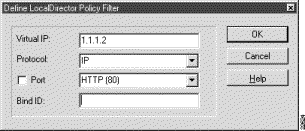
Step 4 Complete the entries in the dialog window. Click OK when completed.
Step 5 Select a precedence from the pulldown menu in the Define Policy Action frame of the Policy Manager window.
Step 6 Click the Save icon in the toolbar or click File>Save from the menu row to save the new policy in the database. This sets the device policy in the Distribution Manager.
Step 7 Distribute your policies to the network.
(a).  Click the Distribution Manager button, or select Tools>Distribution Manager, to start Distribution Manager.
Click the Distribution Manager button, or select Tools>Distribution Manager, to start Distribution Manager.
(b). In Distribution Manager, select the job that appears in the tree view.
When you select the job, QoS Policy Manager displays the contents of the job in the list view, which shows the devices whose configurations will be changed by the job. If you double-click the device name in the list view, QoS Policy Manager displays the IOS commands that will be sent to the device when you apply the job.
QoS Policy Manager starts applying the changes defined in the job to the network devices. You can view the results of the jobs in the logs displayed in the bottom pane of Distribution Manager.
This lesson will teach you how to control Frame Relay Traffic Shaping (FRTS) on Cisco routers. Through FRTS it is possible to have a view virtual point-to-point connections over one physical connection.
You can use FIFO, priority queuing, or custom queuing on frame relay subinterfaces. If you use priority queuing or custom queuing, you must create policies on the interfaces or subinterfaces that create the required queues. On a FR interface you can use WRED and weighted fair queuing (WFS).
Parameters that you can control on FRTS interfaces through QoS are rate (CIR), burst size (BC), excess burst size (BE) and adaptive rate (response to BECN notifications).
The New Device window is displayed.

Or, if you are manually creating this device, fill in the New Device window. At minimum, you must supply this information.
Step 2 Add the router interfaces to the QoS database.
The New Interface dialog window is displayed.
Or, if you are manually defining the interfaces, click the Define Interfaces button, then fill the entry boxes in the dialog window.

Step 3 Select the QoS Property of the interface from the pulldown menu.
Step 4 Fill the Committed Information Rate parameters.
If you wish to create another Interface repeat this step. When all the interfaces are completed, go to Step 3.
Step 5 Save the new device and interfaces in the database.
(a). Click OK in the New Device dialog window.
(b). Click the Save icon in the toolbar, or select File>Save in the menu row. This sets the new policy in the Distribution Manager.
Step 6 Distribute your policies to the network.
(a).  Click the Distribution Manager button, or select Tools>Distribution Manager, to start Distribution Manager.
Click the Distribution Manager button, or select Tools>Distribution Manager, to start Distribution Manager.

When you select the job, QoS Policy Manager displays the contents of the job in the list view, which shows the devices whose configurations will be changed by the job. If you double-click the device name in the list view, QoS Policy Manager displays the IOS commands that will be sent to the device when you apply the job.
QoS Policy Manager starts applying the changes defined in the job to the network devices. You can view the results of the jobs in the logs displayed in the bottom pane of Distribution Manager.
In this lesson you will learn how to adapt your existing QoS Policy Manager database to upgrades on your routers' IOS. Any of your routers can be upgraded to a higher level IOS, such as IOS 12.0, with little impact on the QoS Policy Manager by using the following procedure.
Step 2 Verify the router using the QoS Policy Manager. In the Devices menu, click Devices>Properties. This opens the Device Properties window.
Step 3 Select Verify Device Info. QoS polls the router and updates the information on the screen.
Step 4 Save the new configuration to the database. QoS automatically converts implementation conflicts for the current IOS version on the device. Click the Save icon in the toolbar, or click Save in the File menu. When the database is changed, the Policy Manager creates a new distribution job in the Distribution Manager to update the CLI commands in the router.
Step 5 Distribute your policies to the network.
(a).  Click the Distribution Manager button, or select Tools>Distribution Manager, to start Distribution Manager.
Click the Distribution Manager button, or select Tools>Distribution Manager, to start Distribution Manager.
(b). In Distribution Manager, select the job that appears in the tree view.
When you select the job, QoS Policy Manager displays the contents of the job in the list view, which shows the devices whose configurations will be changed by the job. If you double-click the device name in the list view, QoS Policy Manager displays the IOS commands that will be sent to the device when you apply the job.
QoS Policy Manager starts applying the changes defined in the job to the network devices. You can view the results of the jobs in the logs displayed in the bottom pane of Distribution Manager.
While much of the CLI coding remains the same, there are some translations of how the features are implemented. These are noted in the following table.
Table 3-4 IOS Upgrade Transitions in QoS Policy Manager Implementation
|
![]()
![]()
![]()
![]()
![]()
![]()
![]()
![]()
Posted: Mon Aug 18 10:21:29 PDT 2003
All contents are Copyright © 1992--2003 Cisco Systems, Inc. All rights reserved.
Important Notices and Privacy Statement.